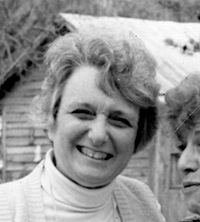 |
| Kathleen "Kat" Kinkade (1930-2008) |
I hope we can rekindle in ourselves the vision of an earth made fair and all her people one. We need communities – many of them not farms – where a vision of possibility of transformation shines like...like a flame in a chalice.
In most faith congregations, the members do not share all of their incomes. They share just some of it – a mere 10 percent, and usually less than that. Congregation members don’t hold all property in common, but many of them do own some land and a building held in common. At Twin Oaks, people take a term as a manager of one area of running the place. In my congregation, we call that being a committee chair. At Twin Oaks the average length of membership of the current members is 7 years, and that’s about the same as the average length of membership at a typical Unitarian Universalist congregation.
We must have communities of love and care. And that may be one area where the nonreligious communes like Twin Oaks are most apt to fail their members.
Kat Kinkade was one of the eight original founders of Twin Oaks in 1967. She was 36-years-old then, and she stayed with Twin Oaks through its first decade, after which she left the community for some extended periods, but always returned. Her 1974 book, A Walden Two Experiment: The First Five Years of Twin Oaks Community, chronicled life and development in the commune. She followed up twenty years later with: Is It Utopia Yet? An Insider’s View of Twin Oaks Community in its Twenty-Sixth Year (1994). Kat Kinkade died at Twin Oaks in 2008, at age 77. Interviewed in 1998, she said of her cherished utopia into which she had poured all that she was and had for so many years:
“Twin Oaks never did love me. It respected me and it feared me, but it never did love me.” (Tamara Jones, “The Other American Dream,” Washington Post Magazine, 1998: download PDF here.)Perhaps Twin Oaks missed step one in its quest to get to steps four and five and six. Step one is: be a place of care, to nurture each other, nurture our souls. From there we cultivate our spirits, and from there we help heal this world.
We are here to become something new on this earth: our true selves as we become when we are held in a community context that situates us, that locates us, that places us in acceptance of ourselves and acceptance of others.
We are here to be transformed by finding in ourselves the place of compassion, to bring that radical liberating energy to the world. We are here to be the community we dream of. Where did nowhere go? Look around. It's not the middle of nowhere. But it might be the entry gate.
* * *
This is part 4 of 4 of "Where Did Nowhere Go?"
Previous: Part 3: "Where Did Nowhere Go?"
Beginning: Part 1: "The Utopian Connection"
See also: "Odyssey: part 8: The Commune Attraction"

No comments:
Post a Comment